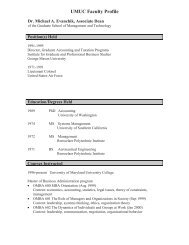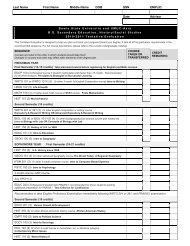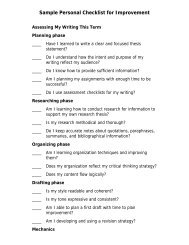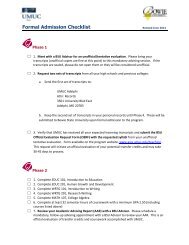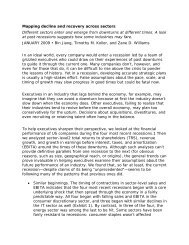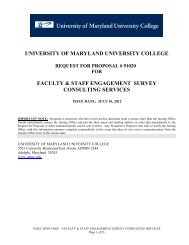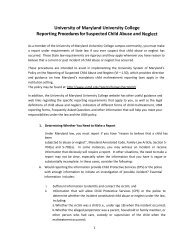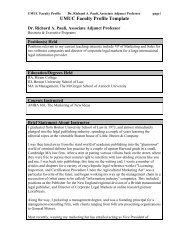COURSE DESCRIPTIONSTLMN 670 Capstone Course in Telecommunications (3)Prerequisite: Completion <strong>of</strong> 27 credits <strong>of</strong> program coursework.The application <strong>of</strong> knowledge and skills gained from previousstudy in telecommunications to real-world projects and torelated business, technical, and ethical issues. Topics includeentrepreneurship and venture creation, emerging telecommunicationstechnologies and their applications, future trends, ethicaldevelopment, and management. Focus is on demonstratinganalytical, entrepreneurial, leadership, planning, managerial, andcommunication skills through a strategic research and developmentproject for a telecommunications company.TMAN (Technology Management)TMAN 600 Foundations <strong>of</strong> Management and Technology (6)A study <strong>of</strong> the foundations <strong>of</strong> management and the principles <strong>of</strong>managing technology in organizations. Topics include variousorganizational factors that affect efficiency and effectiveness andglobal competitiveness, such as group behavior, organizationstructure, environmental factors, international competitiveness,organization culture, change management, decision making,team effectiveness, values, conflict, power, and politics. Ethicsand the socially responsible environment within which mangersmust operate are stressed through readings and practicalapplications. Discussion also covers key concepts <strong>of</strong> technologymanagement and the role <strong>of</strong> technology managers in all sectors<strong>of</strong> the workforce. Focus is on examining technological innovationfrom a historical perspective, including its impact on theeconomy; public policy; global competitiveness; and organizationalstrategy, effectiveness, and efficiency. Students who receivecredit for TMAN 600 may not receive credit for TMAN 611 orTMAN 633.TMAN 611 Principles <strong>of</strong> Technology Management (3)(Formerly TMAN 601.) An introduction to key concepts intechnology management and the role <strong>of</strong> technology managersin both private- and public-sector organizations. How organizationalentities can be structured and managed to respondeffectively to dynamic changes caused by technology and internationalcompetition is examined. The key cycles in the development<strong>of</strong> technology—including their impact on the economy,industrial sectors, and organizational strategy and survival—arecovered from a historical perspective. Management is examinedfrom both a process and system perspective. The major technical,social, legal, and ethical issues in innovating and implementingtechnology are presented.TMAN 614 Strategic Management <strong>of</strong> Technology andInnovation (3)A study <strong>of</strong> the effective management <strong>of</strong> technical organizationsin an increasingly competitive, rapidly changing global environment.A coherent process for the formulation, implementation,and assessment <strong>of</strong> business strategy is provided. A historicalframework for the birth, growth, maturation, and decline <strong>of</strong>business innovation is presented. Findings and recommendationson contemporary businesses and industrial sectors are reported.Technology management is examined within a strategic frameworkthat integrates strategy setting, implementation, and assessmentprocess; historical analogies/cases <strong>of</strong> business innovationthrough maturation lifecycle; and application <strong>of</strong> lessons learnedin contemporary business cases in business, government, andnonpr<strong>of</strong>it organizations.TMAN 625 Economics and Financial Analysis forTechnology Managers (3)A study <strong>of</strong> the financial tools managers use to find answers t<strong>of</strong>our important questions: What is the financial condition <strong>of</strong>the firm? What long-term investment should the firm make?How can the money be raised for the investments? And how willthe firm meet its daily financial requirements? Topics includeaccounting statements, tax implications, types <strong>of</strong> costs, pr<strong>of</strong>itrecognition, financial markets, investment decision tools, netpresent value, free cash flows, project financing, valuation <strong>of</strong>firms, risk-return, cost <strong>of</strong> capital, long-term financing, shorttermfinancing, and equity financing for entrepreneurs. Discussionalso covers mergers and acquisition activities, governanceand ethics, and international aspects. Business cases from contemporaryfirms and readings relevant to technology managementare used to illustrate the application <strong>of</strong> financial concepts.TMAN 632 Organizational Performance Management (3)An overview <strong>of</strong> the most successful strategies and approaches forachieving a high-performing organization, based on the latestresearch findings and the examples <strong>of</strong> successful global organizations.Topics include organizational capabilities in managingcosts, ensuring quality in products and services, and enhancingcustomer satisfaction, as well as performance capabilities (such asorganizational values, adaptability, flexibility, agility, responsiveness,and decisiveness) that enable organizations to anticipateand respond to change. The Baldrige Criteria for PerformanceExcellence are examined as assessment tools for achievingdesired organizational capabilities. Discussion also covers specificapproaches that contribute to high performance and organizationaleffectiveness, such as customer relationship management,supply chain management, Six Sigma methodology, and otherprocess improvement tools. Successful applications <strong>of</strong> thesestrategies and approaches are illustrated.120G R A D U A T E C A T A L O G | 2 0 1 0 – 2 0 1 1
TMAN 633 Managing People in Technology-BasedOrganizations (3)An overview <strong>of</strong> the management <strong>of</strong> three levels <strong>of</strong> behavior inorganizations: individual employee behavior, group behavior,and organizational behavior. Topics include emerging organizationalbehavior issues such as knowledge management, workdesign, virtual organizations and teams, contingent workforcemanagement, creativity/innovation, sociotechnical systems, thedevelopment <strong>of</strong> learning and boundary-less organizations, emotionalintelligence, the global workforce, and the formulation <strong>of</strong>pay/retention strategies. Contemporary organizational behaviortheories are linked to their applications in technology-basedorganizations through the use <strong>of</strong> real-life examples, case studies,and current events.UCSP (Special Topics)UCSP 611 Introduction to Graduate Library Research Skills (0)(Required within the first 6 credits <strong>of</strong> graduate study for allnew graduate students and all inactive students who reapplyfor admission.) An overview <strong>of</strong> online library and informationresources—material that is critical for 21st-century managers.An in-depth introduction to the library research process andthe tools necessary to succeed in graduate study are provided.Emphasis is on the efficient and effective use <strong>of</strong> a variety <strong>of</strong>electronic retrieval systems, including the online catalog <strong>of</strong>the <strong>University</strong> System <strong>of</strong> <strong>Maryland</strong> and affiliated institutions(USMAI), UMUC’s subscription databases, and the Web.Discipline-specific research is conducted in order to gain experiencein formulating viable research questions, selecting the mostappropriate investigative methods and resources for research,locating relevant research materials, evaluating the scholarlyvalue <strong>of</strong> sources, and effectively citing sources.UCSP 621 Economics (0)(Recommended as preparation for MGMT 640 for studentswho lack a background in economics.) An overview <strong>of</strong> boththe microeconomic issues <strong>of</strong> supply and demand for individualcompanies and products and macroeconomic issues concerninginflation, unemployment, and recession for the economy as awhole. Basic economic concepts such as opportunities cost, comparativeadvantage, economic efficiency, and the time value <strong>of</strong>money are explored in the context <strong>of</strong> business, government, andpersonal situations.UCSP 630 Introduction to Research Methods (0)(Recommended as preparation for MGMT 650 for studentswho lack a background in statistics.) A presentation <strong>of</strong> basicresearch techniques and methodologies used in organizationalresearch and evaluation studies to make business decisions.Focus is on applying basic research techniques to assess the performance<strong>of</strong> individuals, work groups, and organizations. Topicsinclude principles <strong>of</strong> good data collection, presentation <strong>of</strong> datain tables and charts, summary and description <strong>of</strong> numerical data,basic probability and discrete estimation, the fundamentals <strong>of</strong>hypothesis testing, and the use <strong>of</strong> existing research-based materialsto solve business problems. Discussion emphasizes basicapproaches and beginning skills necessary to evaluate researchmaterials and their use in decision making.UCSP 620 Financial Accounting (0)(Recommended as preparation for MGMT 640 for studentswho lack a background in accounting and finance.) A basicstudy <strong>of</strong> financial accounting, encompassing basic financialconcepts and their use in analyzing financial statements. Thefinancial statements <strong>of</strong> actual companies are analyzed andthe process by which accounting principles are developed isexplored. Emphasis is on gaining an appreciation for howfinancial accounting information can be used to evaluate theeconomic performance <strong>of</strong> companies.w w w.umuc.edu / grad 121
- Page 1 and 2:
2010-2011CatalogGraduate School of
- Page 3 and 4:
From the DeanWelcome to the Univers
- Page 5 and 6:
IMPORTANT DATESCONTACT INFORMATIONA
- Page 7 and 8:
About the Graduate SchoolMISSION ST
- Page 9 and 10:
Online courses maintain the sameaca
- Page 11 and 12:
Other Dual Degree CombinationsMaste
- Page 13 and 14:
DOCTOR OF MANAGEMENT IN COMMUNITYCO
- Page 15 and 16:
student teaching. Students are advi
- Page 17 and 18:
Career Paths■■■■■■■
- Page 19 and 20:
CAREER PATHS■■■■■■■
- Page 21 and 22:
RELATED CERTIFICATE PROGRAMSInitial
- Page 23 and 24:
PartnershipsUMUC currently offers p
- Page 25 and 26:
program emphasizes development of m
- Page 27 and 28:
RELATED CERTIFICATE PROGRAMSInitial
- Page 29 and 30:
■■■■■■■■Government
- Page 31 and 32:
PartnershipAn articulation agreemen
- Page 33:
CAREER PATHS■■■■■■■
- Page 36 and 37:
MASTER’S DEGREE ANDCERTIFICATE PR
- Page 38 and 39:
MASTER’S DEGREE ANDCERTIFICATE PR
- Page 40 and 41:
MASTER’S DEGREE ANDCERTIFICATE PR
- Page 42 and 43:
MASTER’S DEGREE ANDCERTIFICATE PR
- Page 44 and 45:
MASTER’S DEGREE ANDCERTIFICATE PR
- Page 46 and 47:
MASTER’S DEGREE ANDCERTIFICATE PR
- Page 48 and 49:
MASTER’S DEGREE ANDCERTIFICATE PR
- Page 50 and 51:
MASTER’S DEGREE ANDCERTIFICATE PR
- Page 52 and 53:
MASTER’S DEGREE ANDCERTIFICATE PR
- Page 54 and 55:
MASTER’S DEGREE ANDCERTIFICATE PR
- Page 56 and 57:
MASTER’S DEGREE ANDCERTIFICATE PR
- Page 58 and 59:
MASTER’S DEGREE ANDCERTIFICATE PR
- Page 60 and 61:
MASTER’S DEGREE ANDCERTIFICATE PR
- Page 62 and 63:
MASTER’S DEGREE ANDCERTIFICATE PR
- Page 64 and 65:
MASTER’S DEGREE ANDCERTIFICATE PR
- Page 66 and 67:
MASTER’S DEGREE ANDCERTIFICATE PR
- Page 68 and 69:
EXECUTIVE PROGRAMSEver-sharper comp
- Page 70 and 71:
EXECUTIVE PROGRAMSCHIEF INFORMATION
- Page 72 and 73: DUAL DEGREE PROGRAMSMASTER OF BUSIN
- Page 74 and 75: DUAL DEGREE PROGRAMSMASTER OF BUSIN
- Page 76 and 77: DUAL DEGREE PROGRAMSMASTER OF BUSIN
- Page 78 and 79: MASTER’S DEGREE ANDCERTIFICATE PR
- Page 80 and 81: DUAL DEGREE PROGRAMSMASTER OF DISTA
- Page 82 and 83: DUAL DEGREE PROGRAMSMASTER OF SCIEN
- Page 84 and 85: COURSE DESCRIPTIONSINDEX TO COURSE
- Page 86 and 87: COURSE DESCRIPTIONSACCT 613 Federal
- Page 88 and 89: COURSE DESCRIPTIONSASCM 629 Strateg
- Page 90 and 91: COURSE DESCRIPTIONSBSBD (Biosecurit
- Page 92 and 93: COURSE DESCRIPTIONSCJMS 640 Crimina
- Page 94 and 95: COURSE DESCRIPTIONSDBST 667 Data Mi
- Page 96 and 97: COURSE DESCRIPTIONSDMBA (Business A
- Page 98 and 99: COURSE DESCRIPTIONSDMGT 892 Dissert
- Page 100 and 101: COURSE DESCRIPTIONSEDTC 640 Technol
- Page 102 and 103: COURSE DESCRIPTIONSEMBA (Business A
- Page 104 and 105: COURSE DESCRIPTIONSENVM 650 Land an
- Page 106 and 107: COURSE DESCRIPTIONSHAIN 670 Health
- Page 108 and 109: COURSE DESCRIPTIONSHRMD 630 Recruit
- Page 110 and 111: COURSE DESCRIPTIONSIMAN 670 Managin
- Page 112 and 113: COURSE DESCRIPTIONSINMS 630 Espiona
- Page 114 and 115: COURSE DESCRIPTIONSMGMT 615 Intercu
- Page 116 and 117: COURSE DESCRIPTIONSMSAS (Accounting
- Page 118 and 119: COURSE DESCRIPTIONSPMAN (Project Ma
- Page 120 and 121: COURSE DESCRIPTIONSPRPA 650 Public
- Page 124 and 125: ADMINISTRATIONUniversity Systemof M
- Page 126 and 127: ADMINISTRATIONGRADUATE SCHOOL OF MA
- Page 128 and 129: CONTACT INFORMATIONPROGRAM DIRECTOR
- Page 130 and 131: ADMISSION AND ENROLLMENTGeneral Inf
- Page 132 and 133: ADMISSION AND ENROLLMENTBY MAILStud
- Page 134 and 135: ADMISSION AND ENROLLMENTEmployer-Pr
- Page 136 and 137: ACADEMIC AND ADMINISTRATIVEREQUIREM
- Page 138 and 139: ACADEMIC AND ADMINISTRATIVEREQUIREM
- Page 140 and 141: SERVICES AND RESOURCESAvailability
- Page 142 and 143: SERVICES AND RESOURCESStudents must
- Page 144 and 145: SERVICES AND RESOURCESand the compl
- Page 146 and 147: SERVICES AND RESOURCESfor an additi
- Page 148 and 149: FACULTYAbbott, Weldon LeonAdjunct P
- Page 150 and 151: FACULTYBartoo, DianeProgram Directo
- Page 152 and 153: FACULTYCallahan, Caryl A.Collegiate
- Page 154 and 155: FACULTYCrews, Gordon A.Adjunct Prof
- Page 156 and 157: FACULTYEsler, Anne G.Adjunct Assist
- Page 158 and 159: FACULTYGlickstein, Ira S.Adjunct As
- Page 160 and 161: FACULTYHilliard, Philip E.Adjunct A
- Page 162 and 163: FACULTYKeenan, Susan L.Adjunct Asso
- Page 164 and 165: FACULTYLloyd, Karl B.Adjunct Associ
- Page 166 and 167: FACULTYMerkulov, Gennady V.Adjunct
- Page 168 and 169: FACULTYParks, Janet M.Adjunct Assis
- Page 170 and 171: FACULTYRoberts, Judith M.Adjunct As
- Page 172 and 173:
FACULTYSimoncen, Anne LouiseAdjunct
- Page 174 and 175:
FACULTYTurner, Marvin W.Adjunct Ass
- Page 176 and 177:
FACULTYWysocki, Carol D.Adjunct Pro
- Page 178 and 179:
UNIVERSITY POLICIESIV.CRITERIAStude
- Page 180 and 181:
UNIVERSITY POLICIESC. Faculty Advis
- Page 182 and 183:
UNIVERSITY POLICIESREINSTATEMENT OF
- Page 184 and 185:
UNIVERSITY POLICIESB. Directory Inf
- Page 186 and 187:
INDEXAAACRAO. See American Associat
- Page 188 and 189:
INDEXDDatabase systems technologyce
- Page 190 and 191:
INDEXInstructional sites, 4, 127Ins
- Page 192 and 193:
INDEXTechnology managementcourse de
- Page 194 and 195:
NOTES192G R A D U A T E C A T A L O
- Page 196:
ABOUT UMUCUniversity of Maryland Un





